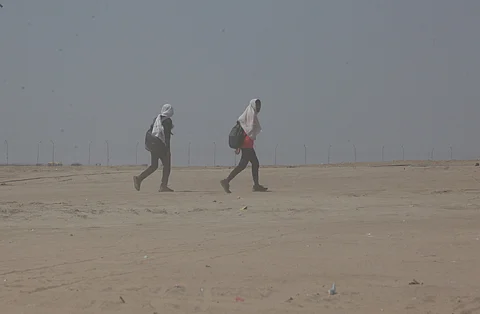

As India grows hotter and climate extremes become more frequent, the toll is increasingly visible in its death registers. A new study has found that nearly 35,000 people died due to extreme temperatures over the last two decades — most of them men.
The study, published in the journal Temperature, reported 19,693 deaths from heatstroke and 15,197 from cold exposure between 2001 and 2019. The authors found that mortality from extreme heat exceeded that from cold, and that men were more vulnerable — a finding that challenged trends seen in many global studies.
“Deaths due to heatstroke is more significant, compared to deaths due to cold exposure, albeit recording an upward trend,” the study’s lead author Pradeep Guin from the OP Jindal Global University (JGU), in Sonipat, India, said in a statement.
Researchers analysed national temperature data from the India Meteorological Department (IMD) and mortality figures from the National Crime Records Bureau (NCRB). The study examined national-level trends between 2001 and 2019 and state-level data from 24 Indian states over the shorter period of 2001 to 2014. The national and state-level data were analysed over different time periods as the available data varied across sources, the researchers wrote in the paper.
The findings showed that both average summer and winter maximum temperatures had risen. A corresponding increase in heat- and cold-related deaths was also recorded, with 2015 marking the deadliest year. India experienced severe heatwaves and cold spells that year, resulting in 1,907 deaths from heatstroke and 1,147 from cold exposure.
While the risks associated with extreme heat were better understood in India, the study noted that several regions also experienced severe cold spells. At the state level, Andhra Pradesh, Uttar Pradesh, Punjab, Odisha and West Bengal recorded the highest heatstroke-related deaths. For cold exposure, Uttar Pradesh, Punjab, Bihar, Haryana and Jharkhand were the worst affected.
The study acknowledged possible discrepancies in death registration and reporting practices across states, which could have influenced the figures.
“To draft a comprehensive response plan and to understand specific needs related to adaptation and resilience, there is a need to understand population-level effects of extreme temperature both nationally and across states, as well as over time,” the researchers wrote in the paper, calling for governments to urgently develop state-focused strategies to reduce such preventable mortality.
The gender analysis revealed stark disparities: Between 2001 and 2019, men were three to five times more likely to die from heatstroke, and four to seven times more likely to die from cold exposure than women. Working-age men (30–59 years) were found to be particularly vulnerable to heat-related deaths.
“The higher death toll from heatstroke in working-age men may reflect the fact that men are more likely to work outdoors than women,” Guin explained.
He urged the suspension of physically demanding outdoor work — such as construction, gig economy work and autorickshaw driving — during heatwaves.
Nandita Bhan, professor and vice dean (academic affairs) at JGU, underscored the need for the research.
“We are convinced now more than ever that this is a really important policy question. Further work and investment by donors is needed to understand the complex links between climate and health,” she told Down To Earth (DTE).
While this study identified higher mortality among men, previous research has produced mixed findings. A 2024 global analysis found stronger evidence from the Global North showing women were more vulnerable to weather-related mortality, whereas data from the Global South — including India — were inconsistent. Of four Indian studies analysed, three suggested that women were at greater risk, while one found the opposite.
The 2024 analysis found that the four Indian studies did not have data on population that mostly stays indoors.
Ramit Debnath, assistant professor and academic director at the University of Cambridge, previously told DTE that Indian studies often excluded populations who mostly remained indoors — typically women. Women in India spend 54 per cent more time indoors than men.
“Staying indoors adds a higher vulnerability factor due to poor built environment conditions like lack of ventilation and cooling agencies,” Debnath said.
The latest study did not look into these issues. “Our study did not focus on indoor heat or air pollution, which is often linked to energy use within homes. Women may be more vulnerable to that, but we do need more evidence,” Guin told DTE.
Going forward, the researchers hope to further investigate the pathways and examine the disease pathways if more granular data is available. They also plan to look at micro data, including any hospital records, which may provide detailed information on cause(s) of death, including identifying any co-morbid conditions that may have become aggravated due to exposure to temperature extremes.
“This will allow for the implementation of better adaptation and mitigation strategies leading to controlling such avoidable deaths,” Guin said.